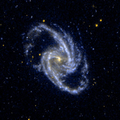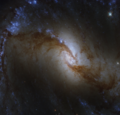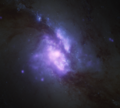NGC 1365
| Galaxie NGC 1365 | |
|---|---|
 | |
| Aufgenommen mit dem Victor M. Blanco Telescope | |
| AladinLite | |
| Sternbild | Chemischer Ofen |
| Position Äquinoktium: J2000.0, Epoche: J2000.0 | |
| Rektaszension | 03h 33m 36,4s[1] |
| Deklination | −36° 08′ 25″[1] |
| Erscheinungsbild | |
| Morphologischer Typ | (R')SBb(s)b Sy1.8[2] |
| Helligkeit (visuell) | 9,5 mag[2] |
| Helligkeit (B-Band) | 10,3 mag[1] |
| Winkelausdehnung | 11′ × 6,2′[2] |
| Positionswinkel | 32°[2] |
| Flächenhelligkeit | 13,9 mag/arcmin²[2] |
| Physikalische Daten | |
| Zugehörigkeit | Fornax-Galaxienhaufen, LGG 94[1][3] |
| Rotverschiebung | 0.005457 ± 0.000003[1] |
| Radialgeschwindigkeit | (1636 ± 1) km/s[1] |
| Hubbledistanz H0 = 73 km/(s • Mpc) | (68 ± 5) · 106 Lj (20,7 ± 1,5) Mpc [1] |
| Absolute Helligkeit | −20 mag |
| Masse | ca. 3,9 · 1011 M☉ |
| Durchmesser | ca. 200.000 Lj[4] |
| Geschichte | |
| Entdeckung | James Dunlop |
| Entdeckungsdatum | 24. November 1826 |
| Katalogbezeichnungen | |
| NGC 1365 • PGC 13179 • ESO 358-017 • MCG -06-08-026 • IRAS 03317-3618 • SGC 033141-3618.4 • VV 825 • GC 731 • h 2552 • Dun 562 • HIPASS J0333-36 • LDCE 0249 NED015 | |
NGC 1365 ist eine Balken-Spiralgalaxie vom Hubble-Typ SBb im Sternbild Fornax am Südsternhimmel. Die Ausprägung der Balken ist markant und sie zählt zu den bekanntesten Balkenspiralgalaxien. Die Galaxie ist etwa 68 Millionen Lichtjahre entfernt und hat einen Durchmesser von über 200.000 Lichtjahren. NGC 1365 ist eine Typ-2-Seyfertgalaxie und gehört dem Fornax-Galaxienhaufen an. Von der Erde aus gesehen rotiert sie im Uhrzeigersinn; eine komplette Umdrehung dauert etwa 350 Millionen Jahre.
Besonders interessiert die Astronomen die komplexe Bewegung der interstellaren Materie in der Galaxie und wie sie die Gasvorräte beeinflusst, aus denen dann neue Sterne entstehen. Der gewaltige Balken sorgt für Störungen im Gravitationsfeld der Galaxie, durch die in bestimmten Bereichen Gas komprimiert und dadurch Sternentstehung angeregt wird. In den Spiralarmen sind unzählige junge Sternhaufen zu erkennen, jeder enthält Hunderte oder Tausende junger und heller Sterne, die alle innerhalb der letzten zehn Millionen Jahre entstanden sind.[5]
Wie bei Spiralgalaxien üblich ist das Zentrum von NGC 1365 ein supermassives Schwarzes Loch (SMBH). Durch einen glücklichen Zufall (eine Gaswolke schob sich in die Sichtlinie zwischen der Erde und dem Zentrum der Galaxie) konnte vor kurzem mittels des im Weltraum stationierten Röntgenteleskops Chandra die Röntgenstrahlen ausstrahlende Gasscheibe um das Schwarze Loch vermessen werden. Der Messung zufolge hat die Gasscheibe einen Durchmesser von 7 AE, was lediglich dem Zehnfachen des errechneten Ereignishorizontes entspricht.[6] In NGC 1365 wurden bisher vier Supernovae beobachtet: SN 1957C (Typ unbekannt), SN 1983V (Typ Ic), SN 2001du (Typ II-P) und SN 2012fr (Typ Ia).[7]
Das Objekt wurde am 24. November 1826 von dem schottischen Astronomen James Dunlop entdeckt.[8]
- Ultraviolett-Aufnahme, erfasst mit GALEX
- Infrarotaufnahme mithilfe des James-Webb-Weltraumteleskops
- Zentraler Bereich von NGC 1365, aufgenommen vom Hubble-Weltraumteleskop
- Röntgenstrahlung des Zentrums, abgebildet mithilfe des Chandra-Röntgenteleskops
- Aufnahme des Zentrums mithilfe des Very Large Telescope
Literatur
- König, Michael & Binnewies, Stefan (2019): Bildatlas der Galaxien: Die Astrophysik hinter den Astrofotografien, Stuttgart: Kosmos, S. 130
Weblinks
- CDS Portal
- Galaxie NGC 1365 in den Medien
- ESO: Elegante Galaxie in ungewöhnlichem Licht (+Fotos, Karte & Animation) 22. September 2010
- ESO: Im Inneren des Glutofens (+Karte, Fotos & Animation) 13. April 2016
- Spektrum.de: Amateuraufnahmen [1]
- SIMBAD Astronomical Database
- Survey of the Stars (engl.)
Einzelnachweise
Auf dieser Seite verwendete Medien
Autor/Urheber: Judy Schmidt, Lizenz: CC BY 2.0
Dusty, barred spiral galaxy NGC 1365. Interestingly, the dust bar isn't nearly as prominent as it is in visible light. In the center is a modest active galactic nucleus (AGN). The circumnuclear dust is also quite striking.
This time, I was happy to receive the PHANGS team's reduction of the data. Makes it much easier because their mosaic was much better matched and aligned.
Red (screen layer mode): MIRI F2100W Orange: MIRI F1130W Cyan: MIRI F770W
Extra overall brightness in grayscale: MIRI F1000W
North is not up.Autor/Urheber: Judy Schmidt from USA, Lizenz: CC BY 2.0
A composite utilizing both HST and CXO data to visualize x-ray emission from the galaxy's nucleus. Its bright central supermassive black hole is actively accreting matter and the surrounding disk is glowing hot with x-rays. Star formation encircling the nucleus also heats interstellar gas to create a diffuse, nebular glow further out from the nucleus.
An article describing the observations used to create this image that serendipitously caught a blob of dust eclipsing the black hole is here: chandra.harvard.edu/photo/2007/ngc1365/
A Chandra-only image is here: [1] A wider, HST-only image is here: [2]
This image was possible thanks to data from the following Chandra and HST proposals: Solving the Enigmas of the Nearby Seyfert/Starburst Galaxy NGC1365 with Chandra ACIS-S Active Galaxies and Quasars PHANGS-HST: Linking Stars and Gas throughout the Scales of Star Formation
Chandra data: Violet / Magenta overlay: ACIS .30-7.00 keV Observation IDs: 3554, 6868-6873
HST data: Red: WFC3/UVIS F814W Green: WFC3/UVIS F555W Blue: WFC3/UVIS F438W/F336W/F275W
North is 19° clockwise from up.Autor/Urheber:
Dark Energy Survey/DOE/FNAL/DECam/CTIO/NOIRLab/NSF/AURA
Image processing: Travis Rector (University of Alaska Anchorage/NSF’s NOIRLab), Jen Miller (Gemini Observatory/NSF’s NOIRLab), Mahdi Zamani & Davide de Martin (NSF’s NOIRLab), Lizenz: CC BY 4.0This image captures the elegant galaxy NGC 1365 in the Fornax Cluster of galaxies. Also known as The Great Barred Spiral Galaxy, NGC 1365 is a strikingly perfect example of a barred spiral galaxy. This image shows the galaxy’s prominent bar and its graceful spiral arms, with lanes of dust obscuring the extended diffuse glow of stars. The central bar of NGC 1365 influences star formation throughout the entire galaxy and conceals a supermassive black hole hidden behind multitudes of newly formed stars. Astronomers areinterested in barred spiral galaxies like NGC 1365 for more than just their elegance — these galaxies provide insights into our home galaxy, the Milky Way, which is also a barred spiral galaxy. This image was built up using data from the Dark Energy Survey (DES), an ambitious project which mappedhundreds of millions of galaxies across the Universe using the Dark Energy Camera (DECam) on the Víctor M. Blanco 4-meter Telescope at Cerro Tololo Inter-American Observatory (CTIO). The analysis of data from the Dark Energy Survey is supported by the Department of Energy (DOE) and the National Science Foundation (NSF), and the DECam science archive is curated by the Community Science and Data Center (CSDC) at NSF’s NOIRLab. Cerro Tololo Inter-American Observatory and CSDC are Programs of NOIRLab. One of the highest-performance, wide-field CCD imagers in the world, the 570-megapixel DECamwas designed specifically for the DES and operated by the DOE and NSF between 2013 and 2019. DECam was funded by the DOE and was built and tested at DOE's Fermilab. At present DECam is used for programs covering a huge range of science.
Autor/Urheber: Judy Schmidt from USA, Lizenz: CC BY 2.0
A view of the central portion of The Great Barred Spiral Galaxy from Hubble. This was captured as part of a joint survey with ALMA to study many aspects of young star clusters to better understand star formation. This survey is great for producing high quality images of galaxies because it includes five filters: one near-infrared, one visible green, one visible blue, and two near-ultraviolet. It's possible to create an image with some stunning colors with this extended spectrum, and you don't even have to fiddle with the saturation.
PHANGS-HST: Linking Stars and Gas throughout the Scales of Star Formation
Red: WFC3/UVIS F814W Green: WFC3/UVIS F555W Blue: WFC3/UVIS F438W/F336W/F275W
North is 19° clockwise from up.Autor/Urheber: (Credit) ESO/TIMER survey, Lizenz: CC BY 4.0
A Phenomenal View of a Phenomenal Spiral
The MUSE instrument on ESO’s Very Large Telescope (VLT) in Chile has observed NGC 1365, a double-barred spiral galaxy located about 56 million light-years away in the Fornax galaxy cluster, allowing us to construct this spectacular colour image. The galaxy is also known as the Great Barred Spiral Galaxy, after its two central bar-shaped structures, made up of stars.
The two bars of NGC 1365 are a rare phenomenon and are thought to have originated by the combined effects of galaxy rotation and the complex dynamics of the stars. Its largest bar of stars, too large for its structure to be visible in this image, connects its outer spiral arms to its centre. What we can see is the much smaller second bar of stars, nestled within the main bar. It is likely this secondary bar acts independently of the main bar, rotating more rapidly than the rest of the galaxy.
Standing for Multi-Unit Spectroscopic Explorer, the MUSE instrument captured this image in optical and infrared light, showing the gas and dust in the central region of the galaxy. Installed on Yepun, one of the four 8.2-metre telescopes that make up the VLT, the capabilities of this instrument have allowed for some of the most comprehensive and detailed studies of our Universe to date, including surveys of distant galaxies, supermassive black holes and even the source of gravitational waves.
Credit:
ESO/TIMER survey









